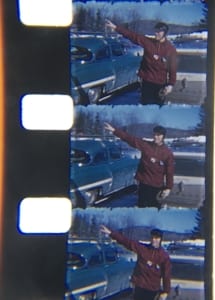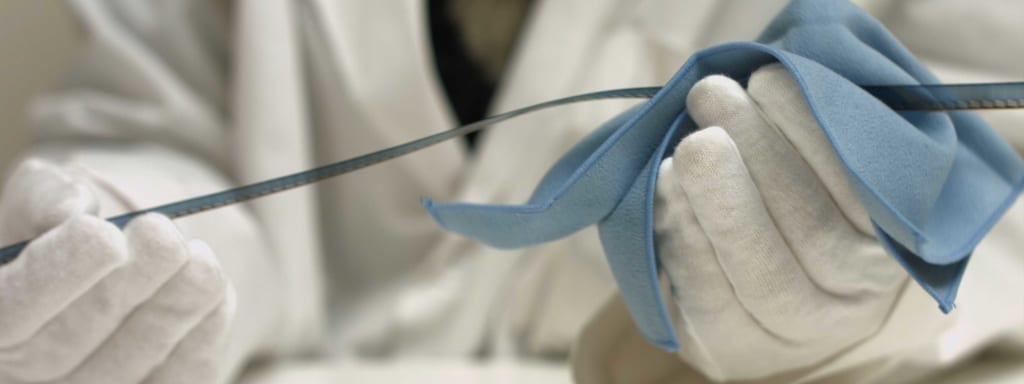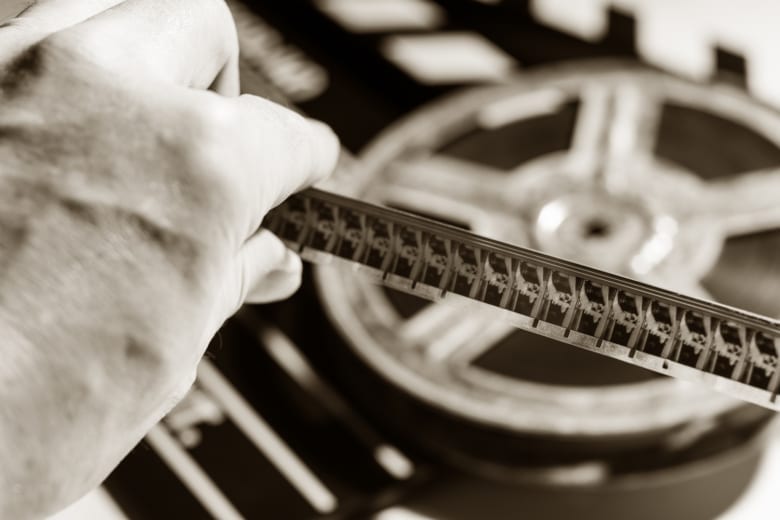Saturday, October 21st was Home Movie Day – a day to celebrate and preserve the memories of home movies! We work with home movies a lot at EverPresent, and we are going to cover some basic tips on caring for film reel collections with professional film technician, Chris Ruble. Film preservation is an ongoing process that includes properly handling and storing films, the copying or digitization of physical material, and of course sharing film memories with others.
While we here at EverPresent take the utmost care in handling and scanning your film elements, once we return the materials, many clients ask us how to keep the originals safe. Your films are often an original one-of-a-kind element of your home movie collection.
About 8mm & 16mm Film Reels
 Most home movie film stocks were reversal films, which means that the same negative that first ran through the camera was later processed into a positive film which could then be projected. When people shot amateur home movies they ended up with only one unique copy when they were done. This is different than professional films which are first shot onto a negative, and afterward, have a separate positive film copy made. This method provides extra copies of the same movie. The reversal film process was convenient and inexpensive for amateur and at-home filmmakers, but it meant that the one film reel element that you were left with had to last a lifetime. After converting your film to digital we can provide you with a DVD copy or a hard drive, but the original is still an irreplaceable item and should be well cared for to remain in good condition.
Most home movie film stocks were reversal films, which means that the same negative that first ran through the camera was later processed into a positive film which could then be projected. When people shot amateur home movies they ended up with only one unique copy when they were done. This is different than professional films which are first shot onto a negative, and afterward, have a separate positive film copy made. This method provides extra copies of the same movie. The reversal film process was convenient and inexpensive for amateur and at-home filmmakers, but it meant that the one film reel element that you were left with had to last a lifetime. After converting your film to digital we can provide you with a DVD copy or a hard drive, but the original is still an irreplaceable item and should be well cared for to remain in good condition.
Film Preservation is valuable for your memories
I work with 8mm movie film and 16mm film reels every day, sometimes we even see 35mm film reels, and the majority of what I see is in very good condition. Most orders that we receive have films on metal or plastic reels in their original cardboard boxes, often appearing just as they did when they were shot decades before. Though films may be ok after being untouched in their original box, here are some additional storage tips to maximize the longevity of your material:
-
- A basic rule of thumb to follow for film reels (and photographs, VHS To Digital, or any other media) is to keep them cool and dry. Film is an organic material and is subject to the laws of nature just as anything else.
- Storing film in the “40-40” range is ideal – an environment of 40 degrees and 40% relative humidity will keep your materials intact for the longest amount of time. If stored in ideal conditions film can outlast any videotape, DVD, or digital file.
- Keeping film stored in the back of the closet is ok, as long as it is dry and out of the sunlight. Find a space at home where the temperature and humidity will stay the most consistent.
- If you want to take your film preservation process to the next level, storing films in the refrigerator or even a freezer is acceptable – as long as it’s not the same one you store food in. A standard consumer fridge or freezer is usable, provided it has adjustable temperature and humidity controls. The ability to properly adjust these two variables will ensure that the material is regulated in a cool and dry environment.
Learn how many feet of film you have at home
- When storing films in their reels or cans, you should remove any pieces of plastic or rubber. To keep it safe as long as possible, the only thing that should be on a film reel is the film. This means removing any tape that may be affixed to the film, or any rubber bands secured to the film. These outside materials may deteriorate onto the film, or introduce other chemicals which can damage the film, or trigger its decomposition.
- If you want to label the contents of your films, write on acid-free paper and affix that to the outside of a film can or box. Do not store paper inside the can with the film.
- Avoid keeping 8mm movie reels or any other film reels in plastic bags, or in airtight containers. Film is meant to breathe, and a small amount of airflow will help any gases that the film emits to escape. Storing film in an airtight environment will trap its emitted gases and this will accelerate the film’s organic deterioration.
If film is left alone in a cool, dry, and breathable environment it can last a long time. If you have a digital copy of your films you can watch and enjoy these memories for years to come. But sometimes it is still fun to watch your film on an actual projector if you happen to have one that still works.

How to handle your film reels
If you are handling film, and why shouldn’t you – it can be very fun and rewarding, just be aware of the condition your film is currently, and the condition you want it to stay in. Here are some tips for handling film.
- Always handle film by the edges, you should try to not touch either flat surface of the film as any dirt or oils from your hands could harm the film.
- If you intend to view the film in a projector, make sure that there are no tears or breaks in the film – especially in the sprocket holes on the edge. This is how the projector pulls the film through its path.
- Film is delicate and any broken sprocket can lead to the film breaking or ripping. When using a projector, first make sure that it is fully operational, and not broken or malfunctioning. Consult the projector’s manual if available.
- Check that the film’s threading path is clear and clean. Any dirt or dust in the projector can scratch the film as it winds along the rollers.
- Do not stop or pause the film while the projector lamp is on, as this can burn or melt the film.
- When winding the film back onto a reel, make sure that it is flat, and does not have any twists or winds.
With the flicker of the projector light and hum of the motor, seeing actual film reels projected on a wall allows you to experience the way these films were first intended to be seen. By following these steps and being careful with your film, you will be able to return to these memories for many many years.
Additional Resources
Along with the Center for Home Movies website, these additional links provide very useful information on caring for your films.
Filmcare.org provides detailed information on proper film storage conditions and allows you to calculate the temperature and humidity based on storage environments and collection sizes.
The Film Preservation Guide is an essential tool for film reel care, and it is available for free in an online PDF.

About the Author
Chris Ruble. Film technician, preservation advocate, and supporter of all physical media.


